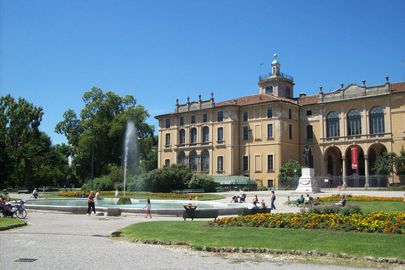

Completed in 1784, the public gardens were named after the eminent 20th century journalist Indro Montanelli only in 2002, after his death.
The area on which the public gardens - the oldest city park in Milan - were built belonged to the noble Dugnani family. In fact, the Dugnani Palace still stands in the westernmost part of the gardens behind the surging fountain. The area consisted mainly of uncultivated land and a few canals, as well as a couple of monasteries. In 1780 Austrian Viceroy of Milan Archduke Ferdinand commissioned architect Giuseppe Piermarini to develop a public park in the style of the French formal gardens with geometric flower beds and tree-lined paths. In the second half of the 19th century architect Giuseppe Balzaretto enlarged the park, modeling his contribution after English landscape gardens with ponds and artificial hills. Later the Natural History Museum was established at the park's southeast corner attracting the public with its aviaries and animal exhibitions. The exhibitions became an independent zoo in 1932, only to be closed 60 years later. In the 1930s the Ulrico Hoepli Planetarium was erected in the northeastern corner, where it still functions today.
The gilded statue of the young Indro Montanelli working with his typewriter, located at the southwestern entrance, was created by sculptor Vito Tongiani and installed in 2002 when the park was renamed. Montanelli, who died in 2001, had been one of Italy's greatest 20th century journalists. He started his career by writing for Fascist newspapers. He even volunteered for the army during the Italo-Abyssinian War, thinking that Italy could bring civilization to Africa. Later, however, he became a critic of Mussolini's political system. He then worked as a foreign correspondent for Corriere della Sera and when he joined the partisans he was captured and even sentenced to death. Fortunately, he escaped. After the war he continued working for Corriere della Sera until 1973, when he left in opposition to the newspaper's new left-leaning management. He thus founded Il Giornale, a rightist newspaper whose headquarters was located just outside the public gardens and which he directed until 1993, when it became the property of Silvio Berlusconi. In 1977 Montanelli was shot four times in the legs by two members of the Red Brigades, an ultra-left militant group. The incident took place approximately where the gilded statue stands today.